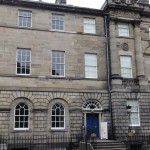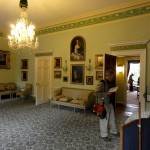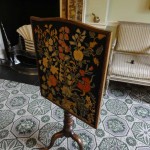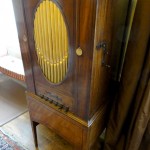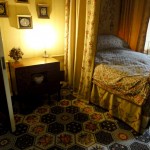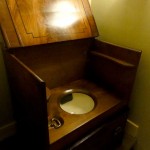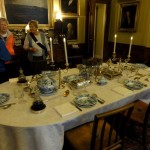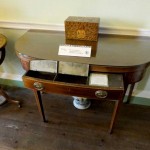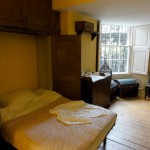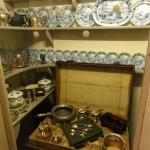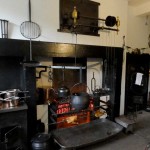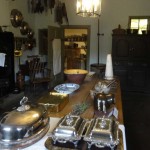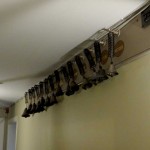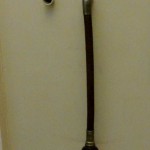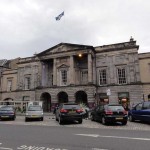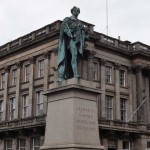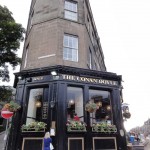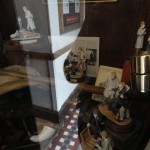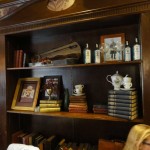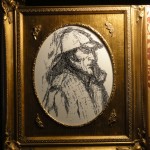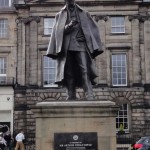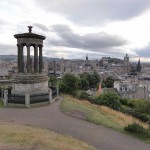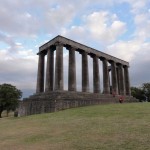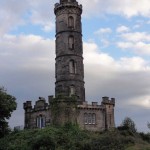Edinburgh Day 2, part 2: New Town
Despite three or four hours at Edinburgh Castle, we still had the resolve to continue our tour of the city, compelled by knowing how little time we had before leaving for Wales. Jim was a little mysterious in his urgency to explore New Town, the Georgian portion of the city that was established by an Act of Parliament in 1753. To build New Town, Nor Loch (where the railway and Princes Street Gardens are now) was drained (probably appreciated by all for it was essentially used as a sewer) and New Town was laid out to the north of the castle. North Bridge was built that connected Old and New towns and the mound was built up north of the castle from all the earth excavated for the new buildings.
New Town is neatly laid out with characteristic squares, crescents and circuses (oval streets). St. Andrew Square is to the east and Charlotte Square (originally to be St. George Square) is to the west and it was to Charlotte Square that Jim was urging me. He surprised me by guiding us to The Georgian House, which is a Robert Adam-designed townhouseActually Adam only designed the facade of the buildings, leaving individual owners to decorate the interiors on the north side of Charlotte Square. It is now owned by the National Trust for Scotland and has been restored to look as it did in about 1815 when John Lamont sold No. 7 to Mrs. Catherine Farquharson for £3,000.
Georgian House was a surprise to me because I had left planning of the Edinburgh portion of the trip to Jim. It also made a nice complement to our tour of the No. 1 Royal Crescent museum in Bath, which we both very much enjoyed. (Jim is far more of a history buff than I.)
I think Georgian House is not quite so grand or large as No. 1 Royal Crescent, but it’s quite enjoyable nevertheless. We arrived about 45 minutes before closing and consequently had to rush, but not all the four floors (the ground and three additional floors) of the house are yet restored, so it was manageable. The two upper floors had been occupied, until recently, by the Moderator of the Church of Scotland (who presides over the yearly general assembly of the church), and now that they’re vacant, perhaps will also be restored to the Georgian period.
Above stairs the restored rooms we visited included the drawing-room, the parlor, the dining room and the main bedchamber, used by Mrs. Lamont and curiously on the ground floor. Below stairs we toured the kitchen, the pantry, the wine cellar, the plate and china closet and the butler’s room.
The house has a few peculiarities and features of interest for a Jane Austen fan fiction author. No. 7 was completed in 1796 during Austen’s lifetime and overall New Town captures the spirit of the Enlightenment like a photograph. Much of the original street plans and buildings remain, which is why Old and New Town Edinburgh is a UNESCO World Heritage Site. The house itself is interesting because of the evidence for bell pulls, speaking tubes and the lack of servants’ stairs. According to the volunteer I spoke with at the house, the speaking tubes and bell pulls were part of the original design. I’d read that bell pulls came into use around the end of the 18th century or the beginning of the 19th, so I’ve worried that including them in my novels is an anachronism (previously a servant would sit outside the door of the drawing-room, alert to being called duty and also consequently eavesdropping).
But I’d never thought of a house at this time having speaking tubes: you speak in one tube and hear the other person’s speech through another tube (full duplex, for the nerds out there). There’s a plot device is ever I heard one. The lack of a servants’ stairs is also interesting and I can imagine that above and below stairs were on more intimate terms than in the archetypal Edwardian manor house where servants would face the wall when their betters passed.
I also enjoyed seeing the spit in the kitchen, powered by a fan in the chimney that turned with the updraft. The bells labeled with each room also did not have those spiral, question mark springs we see on the opening credits of Downton Abbey, but instead depend from a coiled spring.
Unfortunately after our tour of Georgian House, we were not able to take a turn about the gardens in Charlotte Square because they were being prepared to host the Edinburgh International Book Festival. So we continued back through New Town on George Street where we saw statues of Thomas ChalmersLeader of the Church of Scotland, economist, theologian, William Pitt the Youngera Prime Minister during the Napoleonic War, James Clerk MaxwellPhysicist who formulated the classical theory of electromagnetic radiation and my favorite, George IV. I know the man was an idiot, strained the resources of the treasury and was detested by Austen, but still, I’m glad he existed. The statue shows George IV wearing a robe, holding a sceptre and possibly with bare legs. His hair looks like it’s done Roman fashion. We also hurried by the Assembly Rooms, which although not a public venue, still looks elegant inside.
Continuing east, we ended up at The Conan Doyle, a pub at the foot of Calton Hill and very near the birthplace of Sir Arthur Conan Doyle, the creator Sherlock Holmes. It’s a very nice pub with understated nods to its namesake—a portrait of Doyle, some newspaper clippings and a nice display in the window, but not overdone. Unfortunately it was blistering hot inside and I made the mistake of ordering what I thought was a small beer. Understand that I’m actually allergic to alcohol—I grow red faced, my hands and my sinuses swell up and my pulse pounds. I go from happy to drunk to hung over and sober in something like 30 minutes. I usually drink about 4 ounces at most but the bartender handed me a full pint of what proved to be a pretty strong beer, of which I drank about half.
By some miracle, the beer only made me extremely happy and I was spared the uncontrollable laughter and the feeling that my heart would explode. Jim assures me that’s the sign of a good beer.
I staggered out of there and then we climbed Calton Hill to see some of those iconic images of Edinburgh, with the Dugald Stewart monumentA Scottish philosopher and mathematician of the Enlightenment in the foreground and looking toward Old Town and the castle. We also strolled toward the Nelson Monument (where the time ball supposedly drops) and the National Monument of ScotlandBegun in 1826, the monument was modeled on the Parthenon and was to honor the Scottish soldiers and sailors who died in the Napoleonic War. It was never finished because of lack of money.. There are also beautiful views of Arthur’s Seat and the Firth of Forth. It was quite magical up on the hill with dusk falling and me still glowing from the beer.

